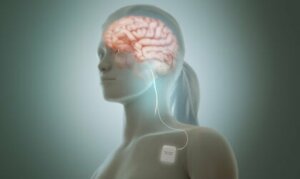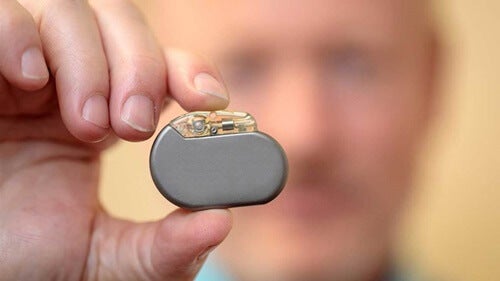Vagus Nerve Stimulation Reduces Depression Symptoms


Written and verified by the psychologist Valeria Sabater
Recent studies are showing that vagus nerve stimulation can reduce the symptoms of treatment-resistant depression. There’s a significant improvement in patients who don’t respond to ordinary treatments. In cases where psychotherapy and drugs aren’t effective, this technique, based on electrical stimulation, is changing these patients’ lives for the better.
For those who follow the latest advances in the worlds of psychology and psychiatry, you’ll no doubt know that new times are coming. People like Jim Van Os, psychiatrist and editor of the well-known scientific magazine Plos One, are pointing out something very important. Treating a mental disorder is more than just focusing on the symptoms.
Up to now, we’ve overly focused on the use of labels and the terminology dictated to us almost entirely from the DSM-V (Diagnostic and Statistical Manual of Mental Disorders). However, a person is much more than a diagnosis; they’re infinitely more than their bipolar disorder or schizophrenia.
Authors like Van Os are proposing that treatment should be personalized. This is absolutely essential for people who are suffering from major depression, for example, and who haven’t found a strategy to feel better. In situations like these, it’s necessary to explore other options. Options where the experts and the patients themselves can find the answer that best suits the individual needs.
In recent years, an innovative strategy has been developed: vagus nerve stimulation. The vagus nerve is one of the most important cranial nerves. It’s the cranial pair X in the table of cranial nerves, and is, in turn, the most predominant neural effector in the parasympathetic nervous system.

The relationship between vagus nerve stimulation and treatment-resistant depression
The vagus nerve is one of the most important cranial pairs. It’s the longest one of all, distributed below the level of the head, and forms part of the parasympathetic nervous system. This neural structure is responsible for many different functions, including sending and receiving information from practically all our body’s organs.
Its main task, therefore, is to regulate and be aware of the current sensory situation in our body. It regulates the heartbeat, controls the proper functioning of the digestion system, and even induces relaxation after physical effort. We could say that it’s our body’s supervisor, as it’s always looking out for our well-being. It’s a truly invaluable cranial nerve.
Until not too long ago, experts were aware of its relationship to our states of anxiety and stress. However, in 2006, a study published in the journal Biological Psychiatry showed something even more interesting. As a result of this study, the door opened up for a new therapeutic method for the treatment of resistant depression, by the stimulation of the vagus nerve.
What are the effects of vagus nerve stimulation?
Charles Conway, a psychiatrist at the University of Washington, was clear about the need for developing new strategies to treat treatment-resistant depression. Many patients take up to three or four antidepressants a day without experiencing any improvements. Thus, the goal was clear: to offer these people quality of life.
At the University of Washington School of Medicine, they’ve been experimenting with this method for several years now. So far, they’ve treated 328 patients, with very successful results.
The stimulation of the vagus nerve optimizes the synapse of monoamines in the brain’s neuronal circuit, which becomes unregulated during depression. In addition, it optimizes the function of the cerebral cortex and the amygdala. The amygdala often becomes hyperactivated, and this usually generates feelings of alarm, fear, and discouragement.
Patients with severe and recurrent unipolar and bipolar depression have shown remarkable improvement. So much so that, after undergoing stimulation of the vagus nerve, they’ve begun to show improvements in psychological therapy too.

How do experts carry out vagus nerve stimulation?
Vagus nerve stimulation is carried out by neuromodulation. What this does is to create electrical stimulation which attempts to reactivate the proper functioning of this nerve.
For the treatment to be effective, experts have designed and implanted small devices (by means of outpatient surgery). They implant the device under the skin on the left side of the chest. As soon as it starts working, it begins to send electrical signals through the vagus nerve to the brain. The improvement in mood is noticeable within a few days.
Important aspects of vagus nerve stimulation
Before we finish, there’s one important point we should note. Vagus nerve stimulation isn’t an exclusive or definitive therapeutic strategy to put an end to depression. It’s a mechanism that improves the person’s quality of life and, even more importantly, increases the effectiveness of all other treatments (such as psychological therapy).
It’s like an awakening. This precise and controlled electrical stimulation makes the person feel better. They start to feel receptive and find that they can concentrate again. They regain an interest in watching movies, reading books, and going for walks. Their mood improves and their motivation to make changes starts to awaken.
This is when psychological therapy can be more effective than ever. This is the time when a person can be equipped with adequate strategies to deal with their own situation.
And, finally, another point to consider. Experts estimate that 30-40% of people with major depression may have resistance to treatment. In those cases, vagus nerve stimulation stands out as a highly effective strategy.
All cited sources were thoroughly reviewed by our team to ensure their quality, reliability, currency, and validity. The bibliography of this article was considered reliable and of academic or scientific accuracy.
- Barral, J-P. (2009). Vagus nerve. Manual Therapy for the Cranial Nerves. Elsevier: USA.
- Charles R. Conway, Arun Kumar, Willa Xiong, Mark Bunker, Scott T. Aaronson y A. John Rush. “La estimulación crónica del nervio vago mejora significativamente la calidad de vida en la depresión mayor resistente al tratamiento”. The Journal of Clinical Psychiatry DOI: 10.4088 / JCP.18m12178
- Rea, P. (2014). Vagus Nerve. Clinical Anatomy of the Cranial Nerves. Elsevier Academic Press: UK.
This text is provided for informational purposes only and does not replace consultation with a professional. If in doubt, consult your specialist.








